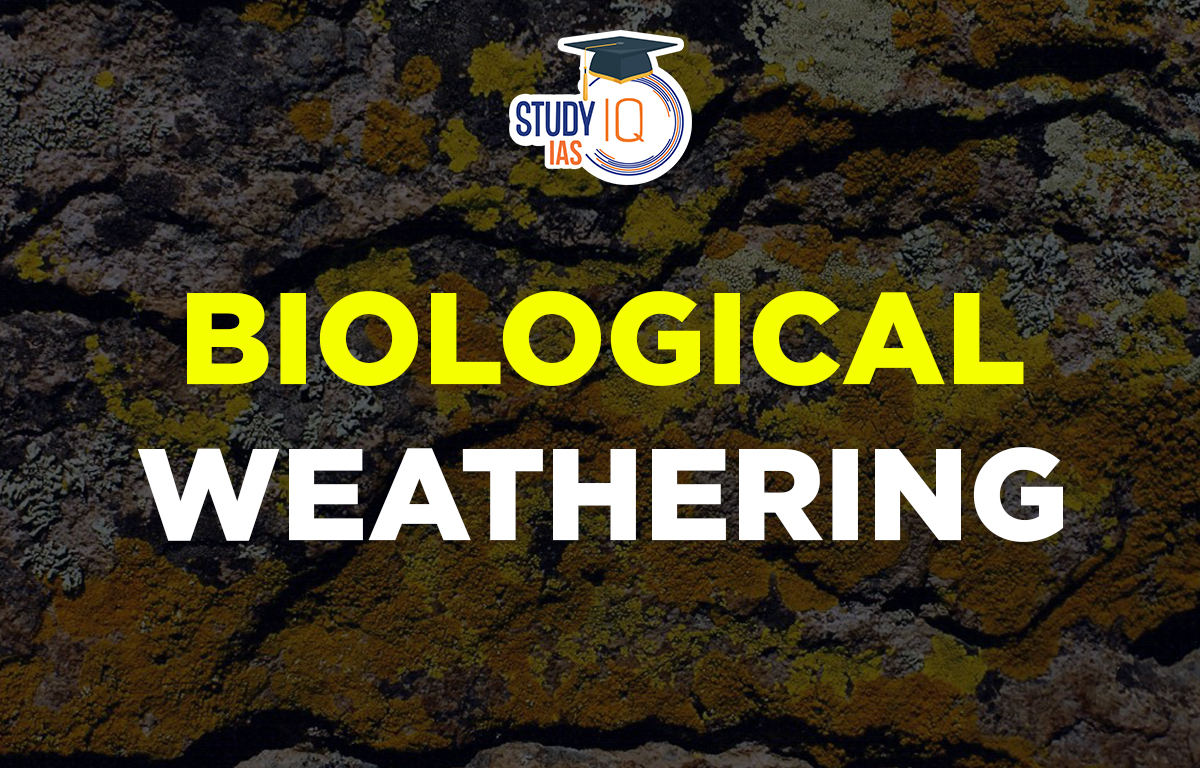Table of Contents
Biological Weathering
Biological weathering is caused by living organisms. This type of weathering shows both physical and Chemical Weathering. For example, plant roots penetrate cracks in the rock and slowly break the rock mechanically. The plant roots secrete certain chemicals to extract minerals, causing chemical weathering. Animals and insects that den or nest or cave in soft rocks fall under Physical Weathering. Anthropogenic activities are one of the most effective agents of biological weathering. Some of the major driving agents influenced by anthropogenic activities are mining, quarrying, excavations, etc. which lead to significant weathering of the surface of the Earth.
Biological Weathering Meaning
Biological weathering is the loss of minerals and ions from the environment due to the growth or movement of living things. It is also called organic weathering. Animals, bacteria, plants, and humans are the main agents. Earthworms, termites, rodents, algae, and decaying plants and animals enrich the soil, which helps with farming and irrigation. When people cultivate and plow the land, they mix soil, minerals, water, and air. At the same time, these organisms create substances that help break down the rocks by absorbing their nutrients.
Biological Weathering Agents
There are mainly 4 Agents of Biological Weathering that are responsible for the Weathering process.
- Animals
- Microorganisms
- Plants
- Humans
Biological Weathering Causes
1. Roots Of Plants
Some trees grow inside rocks, helping with biological weathering. Their roots dig into the soil for moisture and nutrients moving through cracks in the rocks and slowly breaking them apart. Larger roots can also apply pressure on nearby rocks. Additionally, some plant roots release organic acids that help dissolve rock minerals.
2. Microbial Activity
Small creatures including bacteria, moss, lichens, and algae create organic acids. This modifies the rock’s chemical makeup and gradually erodes its outer covering.
3. Animal Burrowing
Some creatures, including moles, squirrels, and rabbits, can cause fissures in rocks. However, by making a fissure, these organisms absorb the nutrients from the rock. It progressively separates the rock into substantial pieces.
4. Anthropogenic Activities
Agriculture, mining, construction, and other human-made soil and rock fracturing are all examples of human activities. The rocks eventually break because of the fissures caused by these actions.
Read More: Types of Rocks
Biological Weathering Types
Biological Weathering can be classified into physical means and chemical means.
Biological Weathering by Physical Means
1. By Plants
Where there is water, plants can grow. By expanding into fractures and fissures in rocks and soil, tree and plant roots can often naturally weather rocks. They are therefore more likely to crack and ultimately disintegrate.
2. By Animals
Burrowing animals like shrews, moles, earthworms, and ants help with biological weathering. They dig holes and bring rock pieces to the surface, making them more vulnerable to weathering. For example, the Piddock shell can burrow through rocks to protect itself. It creates cracks and releases acids that dissolve minerals, breaking the rock into smaller pieces.
3. By Humans
Humans also contribute to biological weathering, even by just walking or jogging, which breaks up the soil into small pieces. Activities like building roads and planting can speed up this process.
Read More: Mass Movement
Biological Weathering by Chemicals Means
1. By Plants
Plants with deep roots can create cracks in marble and limestone by producing acids that corrode the rock over time. When there is more water, rocks break down more easily, and humus, an organic part of soil, helps with this process. When a plant dies, its roots and other parts break down and release carbon dioxide. This CO2 mixes with water to form weak carbonic acid, which can erode the surfaces of rocks.
2. By Microorganisms
Microorganisms can break down even the toughest rocks and soil. Fungi produce chemicals that dissolve minerals in rocks, while algae eat these minerals, causing more cracks and damage. This means broken rocks are more likely to crumble. Actinomycetes, a type of bacteria, have eroded rocks in Egypt by producing acid and leaching minerals and metals.
3. By Animals
Ants and termites can break down rocks both physically and biologically. They create holes in the ground, allowing oxygen and water to enter the soil, which helps break down soil and rocks. When animals die, their bodies turn into compounds that mix with minerals, further affecting the ecosystem.
Biological Weathering Significance
- Weathering weakens the surface materials on the surface of the Earth.
- It helps in soil formation by facilitating silt, clay, and sand.
- Weathering of rocks helps in making fertile plains, beaches etc.
- Minerals created by the weathering process are supplied as nutrients for plant uptake.
Biological Weathering UPSC
The regular actions of organisms result in biological weathering. Humic acids, bioerosion, and biological rock deterioration are examples of organic processes. Biological rock dissolving is induced by bacterial activity. It results from physical changes brought on by organism migration or development as well as the addition or removal of ions and minerals from the weathering environment. It also refers to the deterioration of rock brought on by microorganisms, animals, and plants.
The topic “Biological Weathering”, which is an important element of the UPSC Exam’s Geography Syllabus, should be thoroughly studied by candidates.


 Story of Meera Bai and Her Devotion For ...
Story of Meera Bai and Her Devotion For ...
 Desert Climate, Distribution, Climatic C...
Desert Climate, Distribution, Climatic C...
 Deserts of India Map, Features of Thar D...
Deserts of India Map, Features of Thar D...





















